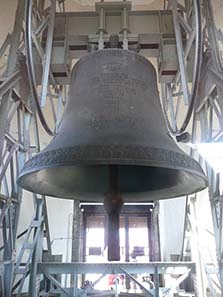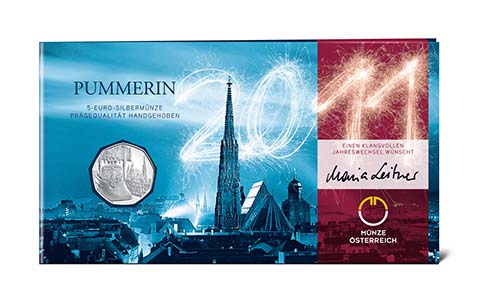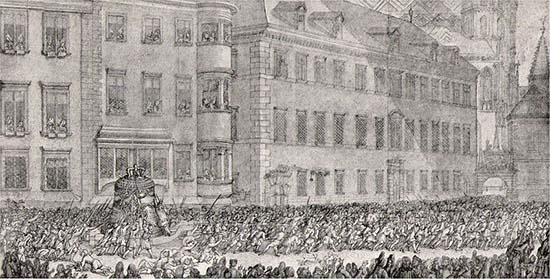December 23, 2010 – The Austrian Mint will issue today the first coin of 2011 celebrating the 300th anniversary of the Pummerin. The Pummerin is the massive bell located high atop the central cathedral of St. Stephen’s of Vienna that annually rings in the New Year.
The Pummerin. Photo: Gryffindor / Wikipedia.
Mint engraver Helmut Andexlinger designed the reverse of the coin by including the top part of the original bell and its very elaborate cast crown of 1711. The lower half of the bell shows the bell in use today that was cast in 1951. The relief located in the center of the bell depicts the Immaculate Conception. The engraver used this relief, common to both the old and the new bell, to connect the representation of the two bells in his design.
Austria – 5 Euro “Pummerin” – 800/1000 Ar – 8 g – 28,5 mm Diam. – Designer: Helmut Andexlinger – Mintage: 50.000 Stück
To the left and right of the central relief of the Immaculate Conception in the top half of the bell are portions of intricate texts in Latin. The bell also has very elaborate detail cast along its bottom and top edges, found on both the new and the old bells. The bell hangs from a very elaborate crown. The word “Pummerin” (or boomer) appears on the right side of the reverse, and underneath are listed the significant years in the bell’s history: 1711, 1945, 1952 and 2011. The name Pummerin and the years form a ribbon, which continues around the back of the bell and sweeps forward in front of the bell from the left side. The sweeping lines coming across the bell from left to right is symbolic of the swinging motion of the bell ringing in of the New Year, and have allowed the engraver to cleverly capture the long history of the Pummerin and its two castings as one. In the background is the distinctive St. Stephen’s Cathedral, which is located in the center of the city of Vienna.
The obverse of the nine-sided coin is the standard 5 euro design, with the denomination encircled by the shields of the nine federal provinces of Austria. In the center is the face value of 5 euros. Helmut Andexlinger also designed the reverse.
The 5 euro face value coin has a diameter of 28.5 mm, contains 8 grams of fine silver and has a fineness of 800.
The coin is available in special uncirculated quality and will have a maximum mintage of 50,000. Each of these coins are vacuumed sealed in a colourful and informative blister pack, with bilingual text in English and German.
Pummerin on Tour
Der Euro-Bus der Nationalbank wird von der Münze Österreich AG als fahrender Münze-Shop umgestaltet und wird vom 22.12. bis 31.12.2010 in Österreich unterwegs sein:
Additional Background Information
Emperor Joseph I commissioned the casting of the original bell in 1711. The bell was known as the Josephinian bell in honor of the Emperor who commissioned it. The metal used to cast the bell was from the cannon balls remaining after the retreat of Turkish forces and their second siege of Vienna in 1683. The original bell weighed 22,215 kilos (almost 49,000 pounds) plus the clapper, which weighed another 813 kilos (1,792 pounds). The height of the bell was 295 cm (9.67 feet) from bottom to top, while the diameter was 320 cm (10.49 feet.)
This bell was so large that when it was ready to be delivered it would not fit through most of the city gates. The bell had to make a major detour to get to the one and only gate which could accommodate its size. This gate was in the area of today’s Morzinplatz, directly on the opposite side of the central cathedral from which the foundry was located. Many of the streets along the circuitous route from the foundry to the cathedral had to be inspected and shorn up during the months prior its transport in order to help ensure that they would not collapse.
Two hundred men from every walk of life volunteered to pull the bell on a specially built and reinforced wagon. Horses were not used because they wanted to guarantee that the journey was totally smooth. The journey of just over 3 kilometers (1.86 miles) took 9 days from October 29 to November 6th. Along the way several doorways had to be removed and two areas of the city walls were heavily damaged. Finally the bell was hung in place in the south tower on December 15, 1711. It rang for the first time, after the newly crowned Holy Roman Emperor Charles VI had returned to Vienna, during a mass of thanks giving on January 27, 1712. It took 16 men a quarter of an hour to pull the bell and get it into full swing in order for it to ring. The Josephinian bell was soon commonly known as the “Pummerin” because of its deep booming tone.
The massive weight of the bell was so great that there was a real concern that ringing the bell would actually cause the cathedral to shift. Therefore, the cathedral architect decided that it could no longer be swung and rung from 1875 on, but rather a clapper was installed to strike the bell instead. The only exception made was during the funeral of the Emperor Francis Joseph I in 1916.
Sadly, this bell was heavily damaged at the end of the Second World War when the Cathedral was burned. The cradle in which the bell was housed was constructed largely of wood. It burned and the massive bell fell to the ground and shattered.
The re-casting of another bell, a national icon of Austria with a long history, was seen as a priority, almost as much as the re-building of the Cathedral itself. It was a gift of the province of Upper Austria that made this a reality and already in 1949 the bell foundry of St. Florian in Upper Austria began to prepare the casting forms.
The new bell, named in honor of St. Mary, is slightly smaller with a diameter of 314 cm (10.3 feet). Its total weight is 20,130 kilos (44,379 pounds), of which 16,592 kilos (36,579 pounds) of metal was used from the original bell. The bell clapper adds an additional 813 kilos (1792 pounds.) The bell is now 294 cm (9.64 feet) high including the crown, which is only one centimeter less than the original one. It is the third largest free swinging bell in Western Europe (the bell of the Cathedral in Cologne is the largest) and is the fifth largest bell in the world. It can be rung up to 34 times in one hour.
After the new bell was cast it was transported in December 1951 from St. Florian first to Linz where it remained on display until April 1952. There was a special exhibit about the old and the new bell and about 70,000 visitors came. When it continued its trip on a specially built low bed truck to Vienna many people turned up along the road to watch the Pummerin go by in a festive atmosphere. At long last it arrived at St. Stephen’s on April 26, 1952 with great celebration and the blessing of the cardinal of Vienna. However, the northern tower where the bell would eventually hang had not yet been rebuilt. Therefore a temporary cradle was built to house the Pummerin for several years in the area in front of the cathedral. The bell rang for the first time from this temporary location on April 27 using the original clapper. Unfortunately the clapper then broke. By May of 1953 the bell had a new electric ringing mechanism.
It was decided to hang the new bell in the shorter and sturdier north tower. Finally the bell was brought into the tower in October 1957 by the main door of the cathedral that had to be enlarged by removing stones, which were replaced once the bell was inside. At long last, the new bell was hung from a steel cradle in the tower and rung for the first time from its permanent location on October 13, 1957. In 2003, a new computer controlled mechanism was installed which insures a smooth swinging action.
The Pummerin is rung regularly once a year to ring in the New Year. The bell is also rung on special occasions such as high points of the Christian calendar and upon the death and election of a new Pope. Moments in global history have also been memorialized by the ringing of the Pummerin such as the signing of the Austrian National Treaty on May 15 1955, the assassination of President John F. Kennedy 22 November 1963 and on September 11, 2001. Every time the bell is rung it is broadcast live on national radio.
If you want to hear the festive ringing of the bell including the Pummerin, click here.
If you want to hear the ringing of the Pummerin, click here.










